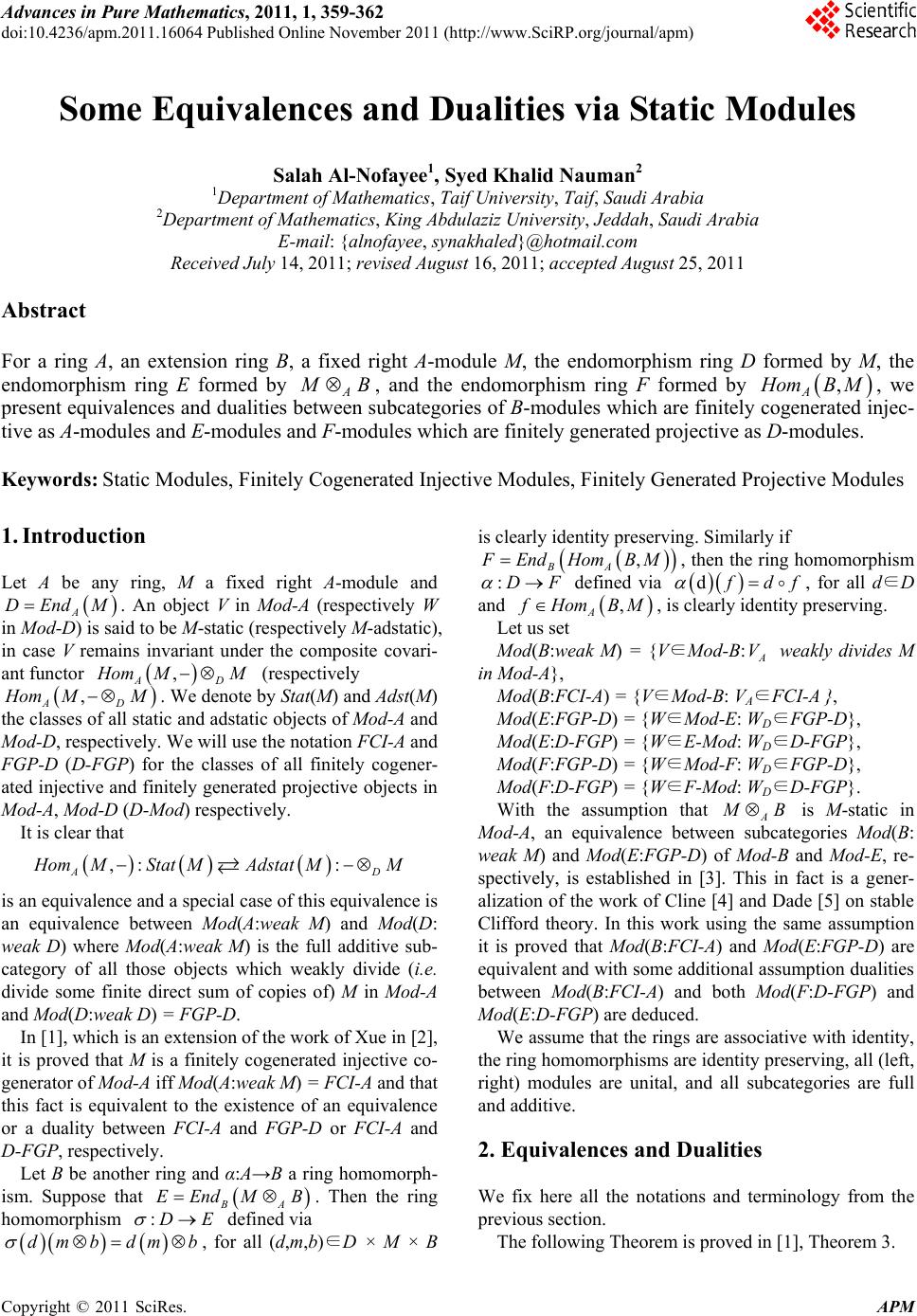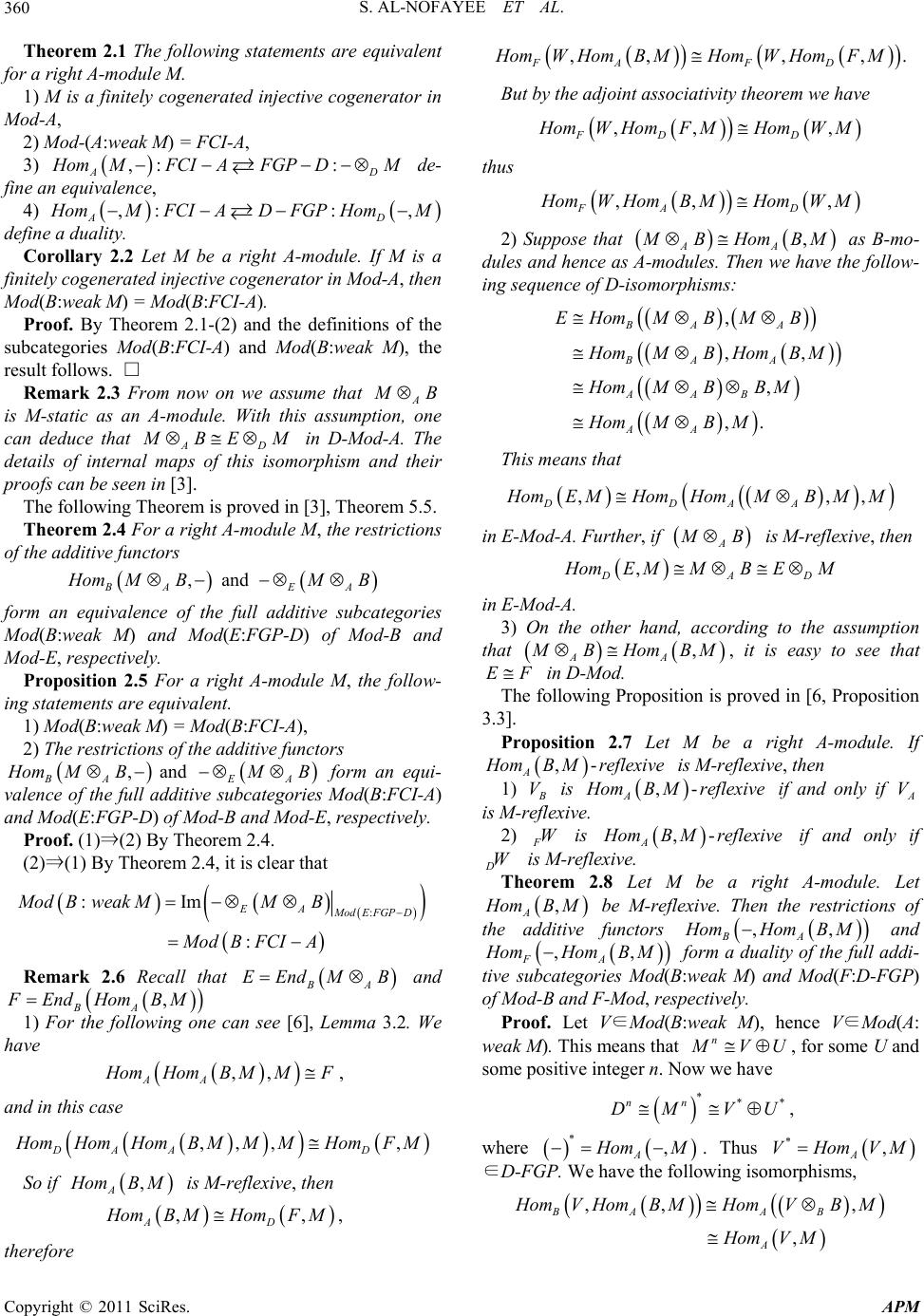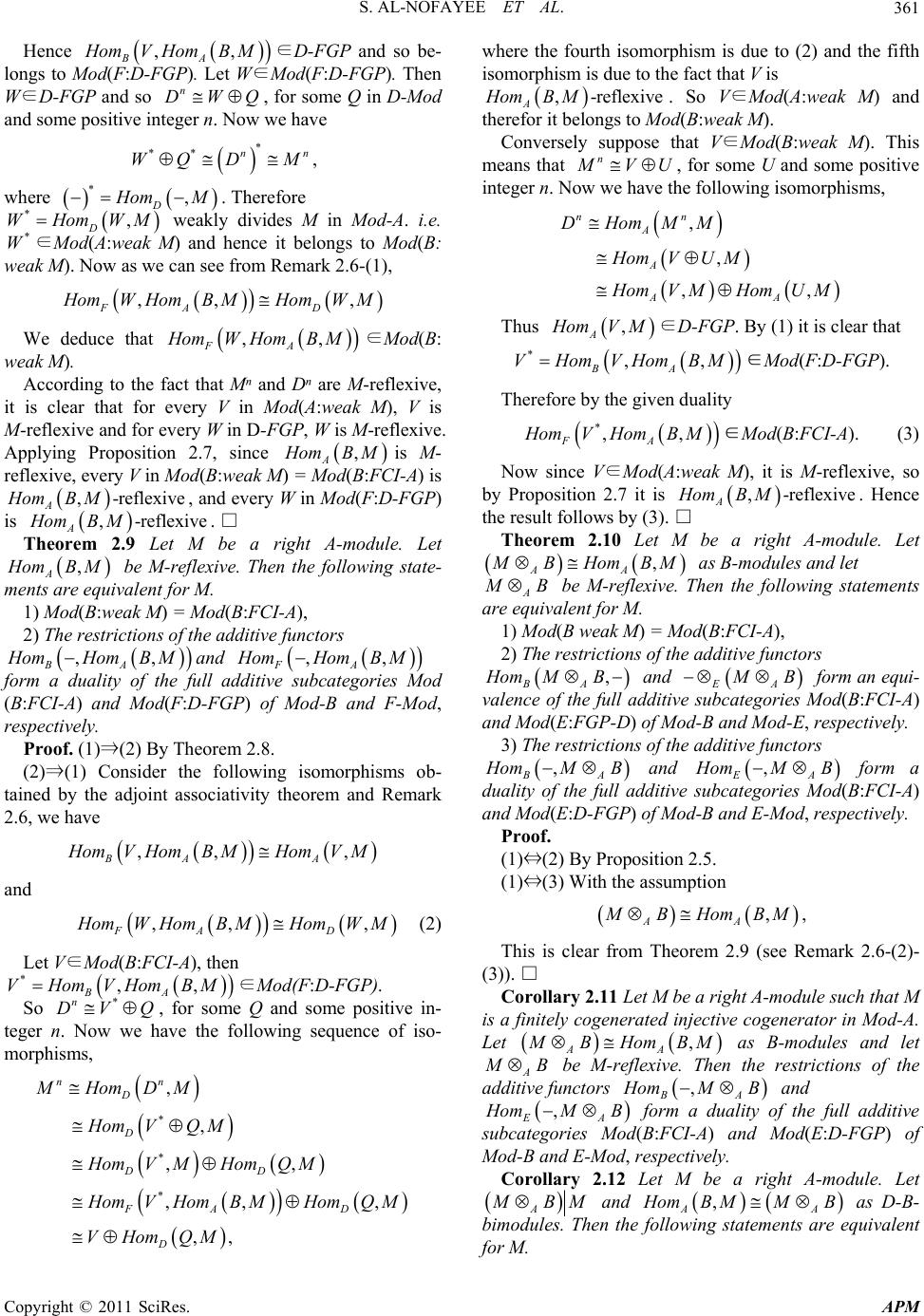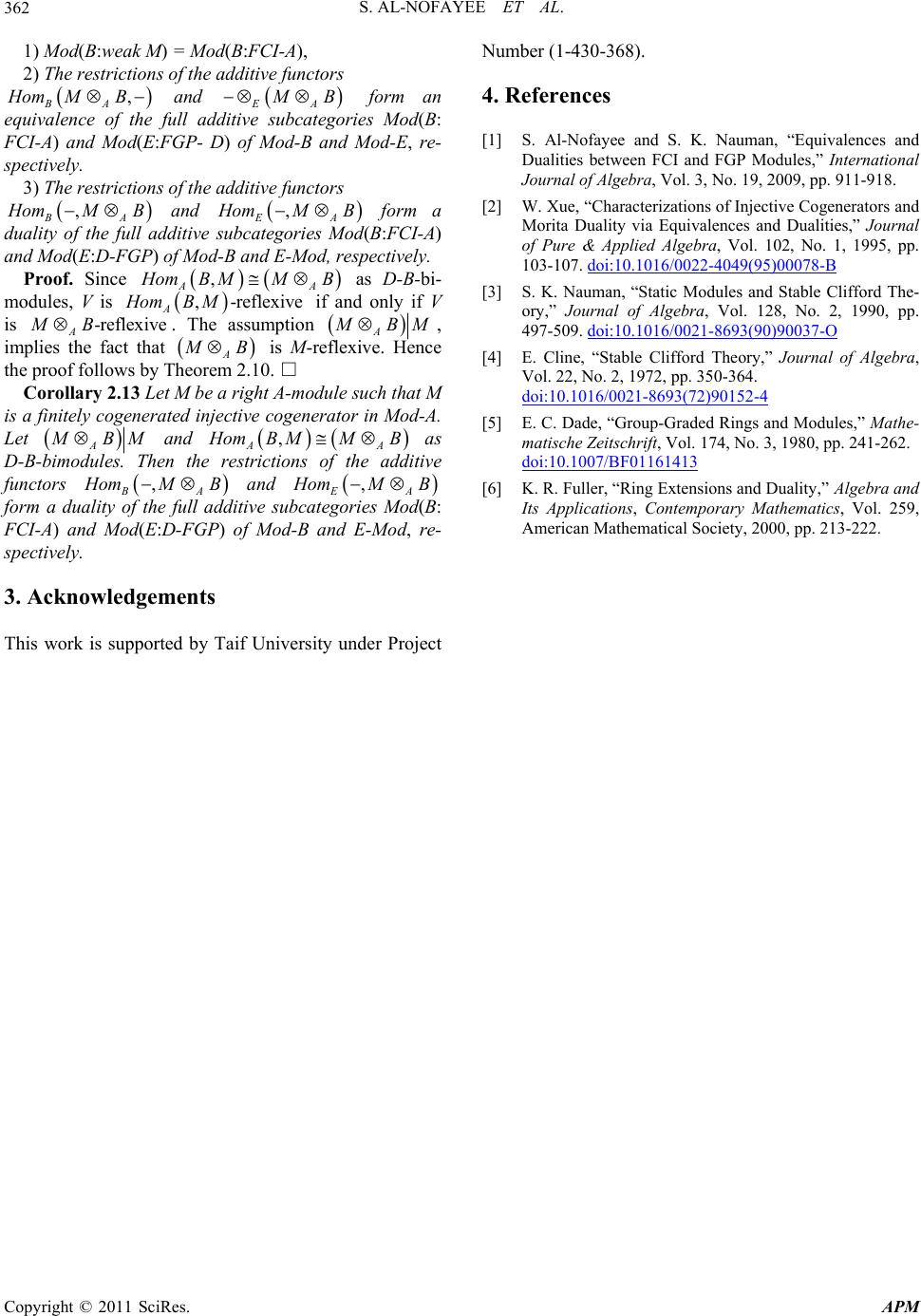 Advances in Pure Mathematics, 2011, 1, 359-362 doi:10.4236/apm.2011.16064 Published Online November 2011 (http://www.SciRP.org/journal/apm) Copyright © 2011 SciRes. APM Some Equivalences and Dualities via Static Modules Salah Al-Nofayee1, Syed Khalid Nauman2 1Department of Mathematics, Taif University, Taif, Saudi Arabia 2Department of Mathematics, King Abdulaziz University, Jeddah, Saudi Arabia E-mail: {alnofayee, synakhaled}@hotmail.com Received July 14, 201 1; revised August 16, 2011; accepted August 25, 2011 Abstract For a ring A, an extension ring B, a fixed right A-module M, the endomorphism ring D formed by M, the endomorphism ring E formed by A B, and the endomorphism ring F formed by , we present equivalences and dualities between subcategories of B-modules which are finitely cogenerated injec- tive as A-modules and E-modules and F-modules which are finitely generated projective as D-modules. , A HomB M Keywords: Static Modules, Finitely Cogenerated Injective Modules, Finitely Generated Projective Modules 1. Introduction Let A be any ring, M a fixed right A-module and . An object V in Mod-A (respectively W in Mod-D) is said to be M-static (respectively M-adstatic), in case V remains invariant under the composite covari- ant functor A DEndM , AD om , A M M (respectively D omM M. We denote by Stat(M) and Adst(M) the classes of all static and adstatic objects of Mod-A and Mod-D, respectively. We will use the notation FCI-A and FGP-D (D-FGP) for the classes of all finitely cogener- ated injective and finitely generated projective objects in Mod-A, Mod-D (D-Mod) respectively. It is clear that ,: : AD omMStat MAdstat MM is an equivalence and a special case of this equivalence is an equivalence between Mod(A:weak M) and Mod(D: weak D) where Mod(A:weak M) is the full additive sub- category of all those objects which weakly divide (i.e. divide some finite direct sum of copies of) M in Mod-A and Mod(D:weak D) = FGP-D. In [1], which is an extension of the work of Xue in [2], it is proved that M is a finitely cogenerated injective co- generato r o f Mod-A iff Mod(A:weak M) = FCI-A and that this fact is equivalent to the existence of an equivalence or a duality between FCI-A and FGP-D or FCI-A and D-FGP, respectively. Let B be another ring and α:A→B a ring homomorph- ism. Suppose that BA EEndM B :DE . Then the ring homomorphism m b defined via , for all (d,m,b)∈D × M × B is clearly identity preserving. Similarly if dmb d , BA EndHomBM :DF , then the ring homomorphism defined via d df , for all d∈D and , A HomB M, is clearly identity preserving. Let us set Mod(B:weak M) = {V∈Mod-B: weakly divides M in Mod-A}, A V Mod(B:FCI-A) = {V∈Mod-B: VA∈FCI-A }, Mod(E:FGP-D) = {W∈Mod-E: WD∈FGP-D}, Mod(E:D-FGP) = {W∈E-Mod: WD∈D-FGP}, Mod(F:FGP-D) = {W∈Mod-F: WD∈FGP-D}, Mod(F:D-FGP) = {W∈F-Mod: WD∈D-FGP}. With the assumption that A B is M-static in Mod-A, an equivalence between subcategories Mod(B: weak M) and Mod(E:FGP-D) of Mod-B and Mod-E, re- spectively, is established in [3]. This in fact is a gener- alization of the work of Cline [4] and Dade [5] on stable Clifford theory. In this work using the same assumption it is proved that Mod(B:FCI-A) and Mod(E:FGP-D) are equivalent and with some additional assumption dualities between Mod (B:FCI-A) and both Mod(F:D-FGP) and Mod(E:D-FGP) are deduced. We assume that the rings are associative with iden tity, the ring homomorphisms are identity preserving , all (left, right) modules are unital, and all subcategories are full and additive. 2. Equivalences and Dualities We fix here all the notations and terminology from the previous sectio n. The following Theorem is proved in [1], Theorem 3.  S. AL-NOFAYEE ET AL. 360 Theorem 2.1 The following statements are equivalent for a right A-module M. 1) M is a finitely cogenerated injective cogenerator in Mod-A, 2) Mod-(A:weak M) = FCI-A, 3) ,: : AD omMFCIAFGP DM de- fine an equivalence, 4) ,:: , AD omMFCIADFGPHomM define a duality. Corollary 2.2 Let M be a right A-module. If M is a finitely cogenerated injective cogenerator in Mod-A, then Mod(B:weak M) = Mod(B:FCI-A). Proof. By Theorem 2.1-(2) and the definitions of the subcategories Mod(B:FCI-A) and Mod(B:weak M), the result follows. □ Remark 2.3 From now on we assume that A B is M-static as an A-module. With this assumption, one can deduce that AD BE M in D-Mod-A. The details of internal maps of this isomorphism and their proofs can be seen in [3]. The following Theorem is proved in [3], Theo rem 5.5. Theorem 2.4 For a right A-module M, the restrictions of the additive functors ,and BA EA om MBMB form an equivalence of the full additive subcategories Mod(B:weak M) and Mod(E:FGP-D) of Mod-B and Mod-E, respectively. Proposition 2.5 For a right A-module M, the follow- ing statements are equivalent. 1) Mod(B:weak M) = Mod(B:FCI-A), 2) The restrictions of the additive functors , and BA EA omMB MB form an equi- valence of the full additive subcategories Mod(B:FCI-A) and Mod(E:FGP-D) of Mod-B and Mod-E, respectively. Proof. (1)⇒(2) By Theorem 2.4. (2)⇒(1) By Theorem 2.4, it is clear that : :Im : EA ModEFGPD ModBweak MMB Mod B FCIA Remark 2.6 Recall that and BA EEndM B , BA EndHomB M 1) For the following one can see [6], Lemma 3.2. We have ,, AA omHomBMMF, and in this case ,,, , DAA D omHom Hom BM M MHomFM So if , A omB M is M-reflexive, then ,, AD omB MHomFM, therefore ,, ,, FA FD HomW HomBMHomW HomFM. But by the adjoint associativity theorem we have ,, , FD D omWHomFMHomW M thus ,, , FA D omWHomB MHomWM , AA BHomBM 2) Suppose that as B-mo- dules and hence as A-modules. Then we have the follow- ing sequence of D-isomorphisms: , ,, , ,. BA A BA A AAB AA EHomMB MB HomMBHomB M HomMBBM HomMB M This means that ,, DDAA , om EMHom HomMBMM A B in E-Mod-A. Further, if is M-reflexive, then , DAD omEMMBEM in E-Mod-A. 3) On the other hand, according to the assumption that , AA BHomBM F , it is easy to see that E in D-Mod. The following Proposition is proved in [6, Proposition 3.3]. Proposition 2.7 Let M be a right A-module. If ,- A omBMreflexive is M-reflexive, then 1) V ,- A is omBMreflexive if and only if is M-reflexive. A V 2) F is W ,- A omBMreflexive if and only if is M-reflexive. D W Theorem 2.8 Let M be a right A-module. Let , A omB M be M-reflexive. Then the restrictions of the additive functors ,, BA omHomBM and , FA , om HomB M form a duality of the full addi- tive subcategories Mod(B:weak M) and Mod(F:D-FGP) of Mod-B and F-Mod, respectively. Proof. Let V∈Mod(B:weak M), hence V∈Mod(A: weak M). This means that n VU, for some U and some positive integer n. Now we have ***nn DM VU, *, A om M *, A VHomVM where . Thus ∈D-FGP. We have the following isomorph isms, ,, , , BA AB A omVHomB MHomVBM HomVM Copyright © 2011 SciRes. APM  S. AL-NOFAYEE ET AL.361 ,, BA omVHomB M n DWQ Hence ∈D-FGP and so be- longs to Mod(F:D-FGP). Let W∈Mod(F:D-FGP). Then W∈D-FGP and so , for some Q in D-Mod and some positive integer n. Now we h ave where the fourth isomorphism is due to (2) and the fifth isomorphism is due to the fact that V is * ** nn WQ DM, where *, D om M , D HomW M . Th erefore weakly divides M in Mod-A. i.e. ∈Mod(A:weak M) and hence it belongs to Mod(B: weak M). Now as we can see from Remark 2.6-(1), * W * W ,, , FA D omWHomB MHomWM We deduce that ,, FA omWHomB M∈Mod(B: weak M). According to the fact that Mⁿ and Dⁿ are M-reflexive, it is clear that for every V in Mod(A:weak M), V is M-reflexive and for every W in D-FGP, W is M-reflexive. Applying Proposition 2.7, since , A omB Mis M- reflexive, every V in Mod(B:weak M) = Mod(B:FCI-A) is , and every W in Mo d(F:D-FGP) is . □ ,-reflexiv A HomB M ,-refle A HomB M e e xiv Theorem 2.9 Let M be a right A-module. Let , A omB M be M-reflexive. Then the following state- ments are equivalent for M. 1) Mod(B:weak M) = Mod(B:FCI-A), 2) The restrictions of the additive functors ,, BA omHomBMand ,, FA omHomB M form a duality of the full additive subcategories Mod (B:FCI-A) and Mod(F:D-FGP) of Mod-B and F-Mod, respectively. Proof. (1)⇒(2) By Theorem 2.8. (2)⇒(1) Consider the following isomorphisms ob- tained by the adjoint associativity theorem and Remark 2.6, we have ,, , BA A om VHomBMHom VM and ,, , FA D omWHomB MHomWM (2) Let V∈Mod(B:FCI-A), then ∈Mod(F:D-FGP). *,, BA VHomVHomBM*n DV Q So , for some Q and some positive in- teger n. Now we have the following sequence of iso- morphisms, * * * , , ,, ,, , ,, nn D D DD FA D D MHomDM HomVQ M HomVMHomQ M omVHom BMHom QM VHomQM ,-reflexiv A HomB Me. So V∈Mod(A:weak M) and therefor it belongs to Mod(B:weak M). Conversely suppose that V∈Mod(B:weak M). This means that n VU , for some U and some positive integer n. Now we have the following isomorphisms, , , ,, nn A A AA DHomMM HomVU M omV MHomU M Thus , A omV M∈D-FGP. By (1) it is clear that *,, BA VHomVHomBM∈Mod(F:D-FGP). Therefore by the given d ua lity *,, FA omVHomBM∈Mod (B:FCI-A). (3) Now since V∈Mod(A:weak M), it is M-reflexive, so by Proposition 2.7 it is ,-reflexiv A HomB Me. Hence the result follows by (3). □ Theorem 2.10 Let M be a right A-module. Let , AA BHomBM as B-modules and let A B be M-reflexive. Then the following statements are equivalent for M. 1) Mod(B weak M) = Mod(B:FCI-A), 2) The restrictions of the additive functors , BA Hom MB EA B and form an equi- valence of the full additive subcategories Mod(B:FCI-A) and Mod(E:FGP-D) of Mod-B and Mod-E, respectively. 3) The restrictions of the additive functors , BA omM B and , EA omM B form a duality of the full additive subcategories Mod(B:FCI-A) and Mod(E:D-FGP) of Mod-B and E-Mod, respectively. Proof. (1)⇔(2) By Proposition 2.5. (1)⇔(3) With the assumption , AA BHomBM , This is clear from Theorem 2.9 (see Remark 2.6-(2)- (3)). □ Corollary 2.11 Let M be a right A-module such that M is a finitely cogenerated injective cogenerator in Mod-A. Let , AA BHomBM as B-modules and let A B be M-reflexive. Then the restrictions of the additive functors , BA om MB and , EA omM B form a duality of the full additive subcategories Mod(B:FCI-A) and Mod(E:D-FGP) of Mod-B and E-Mod, respectively. Corollary 2.12 Let M be a right A-module. Let A BM , AA omB MMB and as D-B- bimodules. Then the following statements are equivalent for M. Copyright © 2011 SciRes. APM  S. AL-NOFAYEE ET AL. Copyright © 2011 SciRes. APM 362 1) Mod(B:weak M) = Mod(B:FCI-A), 2) The restrictions of the additive functors and , BA Hom MB EA B form an equivalence of the full additive subcategories Mod(B: FCI-A) and Mod(E:FGP- D) of Mod-B and Mod-E, re- spectively. 3) The restrictions of the additive functors , BA omM B and , EA omM B form a duality of the full additive subcategories Mod(B:FCI-A) and Mod(E:D-FGP) of Mod-B and E-Mod, respectively. Proof. Since A , A omB MMB ,-reflexive A HomB M xive as D-B-bi- modules, V is if and only if V is A. The assumption -reMBfle A BM, implies the fact that A B is M-reflexive. Hence the proof follows by Theorem 2.10. □ Corollary 2.13 Let M be a right A-module such that M is a finitely cogenerated injective cogenerator in Mod-A. Let A BM and , AA omB MMB A as D-B-bimodules. Then the restrictions of the additive functors , B om MB, EA and om MB form a duality of the full additive subcategories Mod(B: FCI-A) and Mod(E:D-FGP) of Mod-B and E-Mod, re- spectively. 3. Acknowledgements This work is supported by Taif University under Project Number (1-430-368). 4. References [1] S. Al-Nofayee and S. K. Nauman, “Equivalences and Dualities between FCI and FGP Modules,” International Journal of Algebra, Vol. 3, No. 19, 2009, pp. 911-918. [2] W. Xue, “Characterizations of Injective Cogenerators and Morita Duality via Equivalences and Dualities,” Journal of Pure & Applied Algebra, Vol. 102, No. 1, 1995, pp. 103-107. doi:10.1016/0022-4049(95)00078-B [3] S. K. Nauman, “Static Modules and Stable Clifford The- ory,” Journal of Algebra, Vol. 128, No. 2, 1990, pp. 497-509. doi:10.1016/0021-8693(90)90037-O [4] E. Cline, “Stable Clifford Theory,” Journal of Algebra, Vol. 22, No. 2, 1972, pp. 350-364. doi:10.1016/0021-8693(72)90152-4 [5] E. C. Dade, “Group-Graded Rings and Modules,” Mathe- matische Zeitschrift, Vol. 174, No. 3, 1980, pp. 241-262. doi:10.1007/BF01161413 [6] K. R. Fuller, “Ring Extensions and Duality,” Algebra and Its Applications, Contemporary Mathematics, Vol. 259, American Mathematical Society, 2000, pp. 213-222.
|